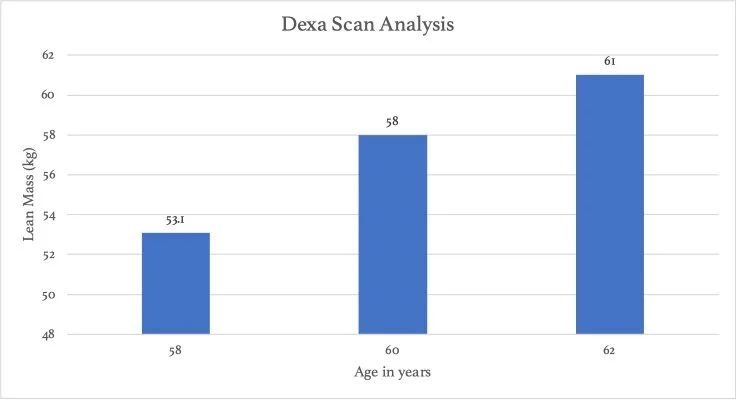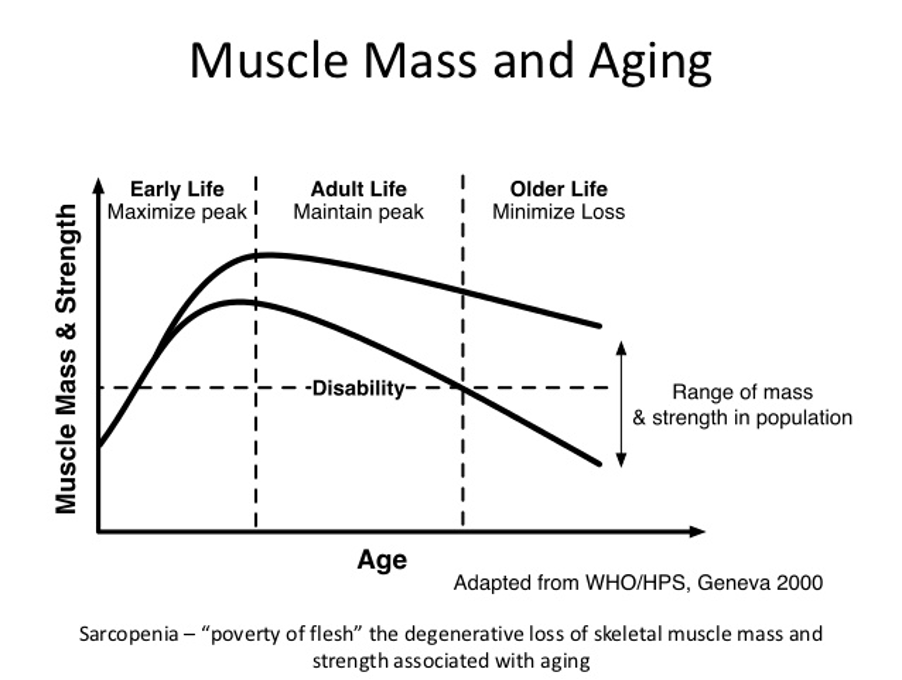PH Therapy - a client case study
If you Google muscle mass you will instantly be hit with companies trying to sell you protein powder, calculations to help you figure out how much muscle you have and, doctors and other professionals telling you why you need it so much. Here, we’re going to discuss the benefits of muscle mass, the challenges we face as we age, and we’ll put this all into context by looking at a case study of a PH Therapy client to show you how PH Therapy can help.
Figure 1. Change in lean mass of a PH Therapy client on a Dexa scan.
Any PH Therapy team member will tell you the importance of muscle mass for longevity, quality of life, improved health outcomes, reduction in disease risk, and improved function of daily activities. You’ll also hear us tell you of the challenges trying to accrue muscle mass as we age. This is true, it is difficult to build muscle mass. However, I would like to draw your attention to the graph above. This is a client we have worked with for the last six years (they are plus 60 years old, an important fact to remember). All our clients are typically referred to us by a GP, consultant, family member or an existing client for us to provide exercise to those with chronic or clinical conditions; this client was referred to us via their cardiologist to help improve key health parameters and reduce disease risk.
Following a clinical letter from their consultant, our new client programmes start with an assessment to get a comprehensive health screening. We cover medical and exercise history and take key measurements such as heart rate, blood pressure, circumferences and body composition to provide a baseline from which we can monitor improvement. We finish assessments with goal setting, to gain an understanding of the client’s motivations. For this specific client, one of their goals was to increase their lean body mass, otherwise known as muscle mass. An excellent choice for a goal.
Why is it even important to build muscle, what is it?
Muscle is key to our health and our ability to function, regardless of age; a baby trying to walk, a teenager playing sport, someone in their 30s looking to remain in their 20s or someone in their 80s trying to make going up the stairs that much easier. It can help protect us from falling, and if we do fall can help us recover faster. It can help prevent us from developing diseases such as cardiovascular disease, diabetes and obesity. It can improve our bone density and reduce the risk of fractures and of losing our independence.
Muscle is a lean tissue made up of proteins (30%) and water (70%), roughly making up 45% of our total weight. When muscle contracts and relaxes, it provides the locomotion that allows our body to perform tasks; from running a marathon to breathing, we need muscle to move. We have three types of muscle in the human body; skeletal, smooth and cardiac muscle. Skeletal muscle is muscle attached to your skeleton and gives us our shape.
Skeletal muscle contains striated muscle fibres composed of 1000s of cells. On stimulation, these fibres contract allowing us to perform specific movements. The strength and size of a muscle will depend on how many fibres each muscle has. Muscles attach to tendons, which attach to bone; as muscle contracts, it pulls on the tendon causing the bone to move in that direction i.e. when your bicep contracts, it brings your forearm closer to your shoulder.
As we age, we naturally begin to lose muscle mass. Roughly speaking, from the age of 30, we will lose around 1% of lean tissue per year, via a natural process called sarcopenia. On top of this, muscle mass is hard to build due to biological changes at the cellular level. It takes time, consistent stimulation and appropriate nutrition.
Advantages of building muscle mass
Improved Strength
Increased longevity, quality of life
Improved body composition (muscle vs fat)
Improved metabolism (energy burn at rest)
Reduce risk to CVD, diabetes, obesity, metabolic syndrome
Improved bone density (harder to fracture bones)
Reduction in falls and injuries
Improved mobility
Better sleep
Improved blood sugar control
Immune system
Improved energy levels
Reduction in stress
Reduction in pain
Figure 2. Changes in muscle mass and strength with increasing age. The graph above helps to visualise the drop off in muscle mass in inactive individuals in comparison to stemming the loss in muscle mass by strength/resistance training. NB: Strength/resistance training does include bodyweight exercises like squats and press-ups and not always large dumbbells.
How would I build it?
Building muscle requires you to provide resistance to your muscles, through resistance training exercises. As a result of resistance training, we undergo a process called muscle protein synthesis, which tells the body we need to adapt to a new stressor; this helps the muscle get stronger and potentially bigger, known as hypertrophy.
Resistance training often has connotations of bodybuilders or sportspeople, however, it has a far wider-reaching remit than that. The common myth is that resistance training must be performed in a gym; not true, the only requirement is that your muscle is acting against a force. Dumbbells, barbells, kettlebells, etc are all very useful when trying to build or strengthen a muscle; however, so is your body weight, resistance bands, stairs, hill walks, or even lifting pots in your garden.
Progressive overload
The progressive overload (PO) principle is an important one. PO exposes your musculoskeletal and nervous systems to greater stress over time; this stress encourages changes in muscle strength, size and endurance. With progressive training, we can achieve better contractility and recruitment of muscle fibres, meaning per contraction we can activate a larger proportion of the muscle.
This process is performed gradually over weeks, months and even years. Stress caused by a specific exercise will cause the muscle to break down; when you rest, the muscle has time to repair through muscle protein synthesis. A simple method of PO is an acronym called FITT, involving changes to the Frequency, Intensity, Time and Type. Changing any of these parameters can lead to changes in your muscle.
What does all this mean to me?
Figure 3. Change in lean mass of a PH Therapy client on a Dexa scan.
Let me draw your attention back to our case study. The graph shows an 8 kg increase in lean mass over a 5-year period, during which our client undertook two resistance sessions per week; roughly 234 resistance sessions in total, accounting for holidays, and other missing sessions.
Our sessions are based around big compound movements targeting multiple muscle groups and multiple joints and using the principle of progressive overload, i.e. each session we look to modify our FIIT acronym. Our client doesn’t go home crawling or unable to walk; in fact, when we check in after their session, they commonly report being a little stiff or completely fine. That’s the beauty of a well-planned programme; it allows you to progress without needing crutches the next day. (No programme should be requiring you to have crutches).
One of the most important aspects of this individual’s success is their consistency in training. Exposing the body and the muscle to a stimulus week after week over time has a huge impact on the muscle’s ability to remodel.
Our client is by no means perfect; their nutrition could improve, their weekly alcohol content could reduce and their consistency with cardiovascular-specific exercise could be improved. However, this individual now has a distinct advantage over their 57-year-old self; he has decreased his risk of falls (excluding clumsiness), decreased his risk of diabetes (see appendix for more), obesity, osteoporosis and improved his ability to perform daily activities. Without resistance training over that time period, sarcopenia would cause a reduction in muscle mass at roughly 1% per year which would see a 2.5 kg decrease in lean mass over the same 5-year period (0.5 Kg (or 1% of 54 Kg) x 5 years). The net improvement against doing nothing at all is now 10.5 kg of lean mass.
Conclusion
Ageing is hard to avoid; however old we think we are, there are some processes that we just can’t run from. We will all naturally begin to lose muscle mass in our 30s, losing this tissue has shown to lead to an array of unfavourable health outcomes and a decrease in daily function and freedom of movement. This all means less fun.
You can slow the natural loss of muscle by including resistance training into your weekly exercise routine, using an assortment of different methods i.e. dumbbells, hill walks, stairs etc. Strength training should be included for everyone, regardless of age and gender. I would go so far as to say that strength training gets more important as we age, with good health and freedom from illness a top priority for everyone.
Should you, or someone you know, wish to undertake resistance training, please don’t hesitate to get in touch - ben.duckett@pandhtherapy.co.uk. We are a team of three Clinical Exercise Physiologists in London, working with people on their cardiac rehabilitation, rehabilitation from other clinical conditions, or simply improving their overall health. The best bit?… We can come to you! Whether that’s to your home or your office. We also have locations in Moorgate, Mayfair and Fulham.
Appendix
What is a Dexa Scan?
A Dexa scan is a dual-energy X-ray absorptiometry device that allows you to measure body composition i.e. bone mineral density, lean mass, fat mass etc. This is the gold standard for measuring your body composition. It is used in a variety of different settings, from doctors analysing the strength of your bones and your risk of fractures, to sports people looking to get an accurate account of their fat mass to muscle mass ratio.
Why has their risk of diabetes decreased?
Type 2 diabetes is a condition where there is too much sugar (glucose) in the blood and insulin, a hormone that helps to transport sugar from the blood to the cell, isn't responsive. Muscle is the biggest site of glucose disposal after eating and thus focusing on exercise that helps to build and/or maintain muscle has seen to improve prognosis and diagnosis of type 2 diabetes.
Dieting and improving your nutrition alone has very positive effects on type 2 diabetes, the most popular diets to recommend are very-low-calorie diets. However, much to their success in the short term, these are very difficult to maintain and sustain for a long period of time. Combining exercise with a balanced nutrition plan will have greater long term results than those who focus solely on diet.
Exercise and more specifically resistance training has the ability to build muscle which can reduce your risk of type 2 diabetes, even walking alone has shown to have positive effects on lean body mass and fat mass.
Maintaining any fat loss or health goal is hard and those who include exercise alongside their diet do have better long term results.



